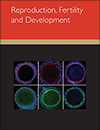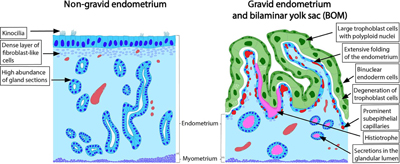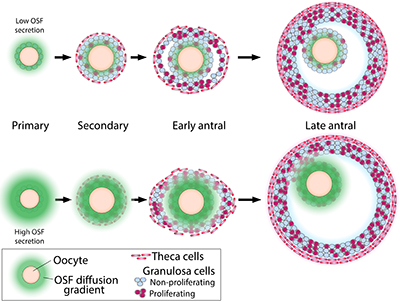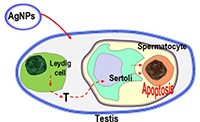Reproduction, Fertility and Development
Volume 37
Number 8 2025
Regulated growth and development of ovarian follicles are important for fertility, and locally produced factors are key regulators of these processes. We investigated whether locally produced platelet derived growth factors (PDGF) play an important role in the growth and function of ovine follicles. Multiple PDGF ligands, as well as their receptors, were expressed in developing follicles, and PDGFBB altered key follicular functions, indicating these growth factors are important for the regulation of growth and development of ovarian follicles in sheep. Image by Jennifer Juengel.
This article belongs to the collection: The biology of the ovary – Honouring the contributions of Ken P McNatty and Rex J Scaramuzzi.
Wallabies require rapid embryonic development as they give birth after a short pregnancy, immediately followed by ovulation. We analyzed and quantified differences between the gravid and the non-gravid uterus, which included a greater blood vessel area and increased surface area in the gravid endometrium and investigated the features ensuring the most efficient embryo-maternal exchange, such as polyploidy of trophoblast cells. However, these adaptations seem to be self-limiting making birth at the designated time inevitable. Image by Marie Muenzenberger.
A very small proportion of eggs in the ovaries are ever ovulated but it is not known how the ovary chooses which eggs ovulate. We discuss the evidence that high-quality eggs produce signals that increase their rate of maturation allowing them to win the race to ovulate. If the ovary can detect which eggs are good quality, then it might be possible to adapt this to improve treatment in fertility clinics. Image by Michael Pankhurst.
This article belongs to the collection: The biology of the ovary – Honouring the contributions of Ken P McNatty and Rex J Scaramuzzi.
The increasing use of nanoparticles, especially silver nanoparticles (AgNPs), in various consumer, agricultural, and pharmaceutical applications has raised considerable concern about their potential risks to human health. However, the progressive toxic effects of AgNPs in mouse testes after single and repeated exposure are still unclear. The present observations show that AgNPs caused potential adverse effects on the testis, specifically, spermatogenic cell apoptosis, impaired spermatogenesis, and reduced testicular testosterone concentrations in an exposure time- and dose-dependent manner. Image by Mohammad Shah Alam.









